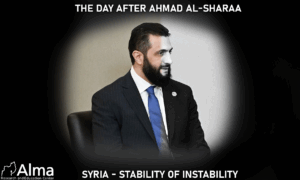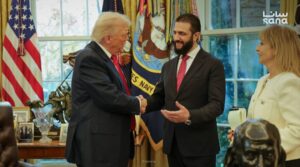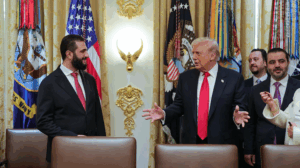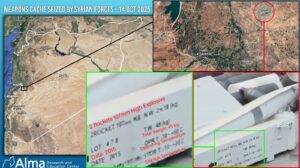Executive Summary
Syria represents a “stability of instability.” Al-Shara, his regime, and his policies face significant challenges and enemies from within.
In the international gamble on Ahmad al-Sharaa as the president of the new Syria, one must consider the realistic possibility that he will not endure.
In the following pages, we will discuss the potential implications of such a situation for the region.
There is a high to very high risk to Al-Shara’s life and rule, primarily from extremist elements within his close circle and the security forces, as well as from ISIS.
Security negotiations with Israel are seen as a “red flag” by extremists and increase the risk of assassination or an internal coup.
In such a case, the most likely scenario, in our assessment, is one of collapse, disintegration, and chaos. This scenario would lead to inter-militia warfare, the strengthening of ISIS, and the re-establishment of terrorist infrastructures in southern Syria.
The chaos scenario would directly lead to a clear and immediate danger—a severe blow to minorities in general and to the Druze in southern Syria in particular.
In addition, external interventions (Turkey, the Shiite axis) may alter the balance of power and pose new risks to the borders.
The primary humanitarian and strategic threat to Israel is the danger of massacre and revenge against the Druze in southern Syria — a situation that requires preparedness for defence, evacuation, and assistance. In such a scenario, Israel would need to adopt a proactive policy to protect the Druze in Syria.
Therefore, Israel and the international system, led by the United States, must prepare in the immediate term for an effective, coordinated response — preventive, defensive, and humanitarian — in close cooperation with regional actors.
This article focuses on a scenario in which al-Shar’a does not endure. This does not imply that the continuation of al-Shar’a’s rule in Syria is without risks to Israel’s security. Given his jihadist background and that of the new regime in Syria, it is difficult at this stage to assess the direction he intends to take and whether he truly seeks to move closer to the West, or whether this is a deliberate deception designed to enable him to establish an extremist Islamist state with Western weaponry on Israel’s border.
General Overview
On November 10, U.S. President Trump hosted Syrian President Ahmad al-Shara at the White House. The meeting likely focused heavily on efforts to advance a security agreement between Syria and Israel; an issue currently being discussed directly by both parties. Various reports indicate that the United States hopes to see this agreement finalized by the end of 2025.
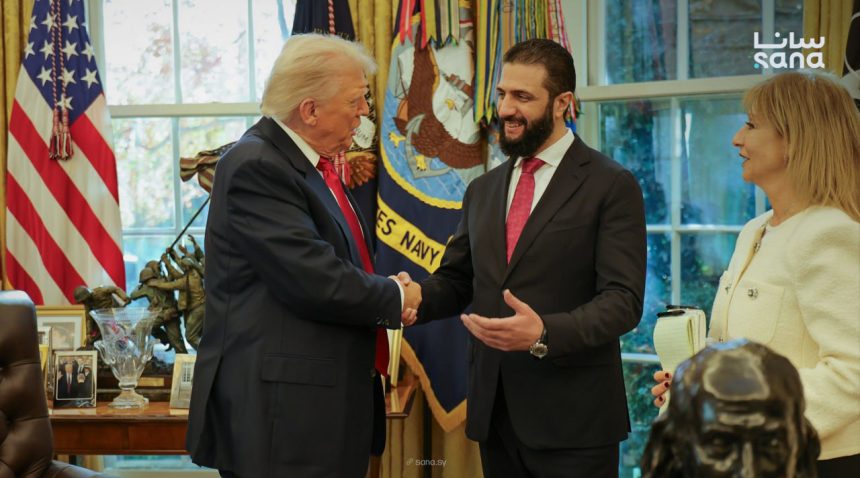
Al-Shara’s regime faces numerous internal challenges: governance difficulties, economic hardship, minority tensions, and many heterogeneous militias (many of which now form the new Syrian army and have been re-branded, yet without genuine dismantlement of global jihadist networks), and other factors that undermine stability.
Since Al-Shara came to power, his regime has worked intensively to consolidate governance and to act against those whom it perceives as threats to stability.
The regime strives to impose authority and public order through internal security forces, often doing so with great aggression, as seen in the Alawite region in northwest Syria in March 2025, and in the Druze region of Sweida in July 2025.
It is possible that the complex reality of the “new Syria” will not necessarily usher in a new and positive era. Instead, it presents knowledge gaps and deep uncertainty about the future and carries significant potential for deterioration and collapse. Syria remains a “stability of instability.”
Enemies from Within
From the regime’s perspective, its actions against the Alawite minority (March 2025) and the Druze minority (July 2025) are part of a policy of strengthening governance.
In the regime’s view, this is a vital necessity comprising authority, stability, public order, and control by the security forces across all of Syria. Although in practice acts of massacre and atrocities were carried out against civilians of these populations, by al-Shar’a’s men.
The Kurds, in the regime’s eyes, also undermine stability. Because of their geographic position, military strength, and U.S. support, the regime is conducting negotiations with them for integration, rather than carrying out the kind of violent purges inflicted on the Alawites and Druze. Nevertheless, daily skirmishes between Kurdish forces and regime troops continue.
Al-Shara also faces other domestic enemies, foremost among them ISIS.
In recent months, the organization has “reared its head” and intensified its activities in Syria, mainly in the east, but also in the south, increasing suicide bombings and attacks on regime and religious targets. One such attack was the deadly suicide bombing at the Greek Orthodox “Elias” Church in Damascus on June 22, 2025, where dozens were killed.
The event involved gunfire at worshippers, followed by the detonation of a suicide vest by the attacker.
The most significant regime activity against ISIS began on November 8, 2025, after Syria was admitted into the international coalition against ISIS. Led by the Syrian Ministry of Interior and the General Intelligence Directorate, 61 raids were carried out on ISIS targets in Aleppo, Homs, Idlib, Damascus, Deir ez-Zor, Raqqa, and the Syrian desert.
According to reports, dozens of operatives, including senior figures, were arrested, and weapons, ammunition, and logistics depots were uncovered.

Moreover, Iranian and Hezbollah presence in Syria, and the broader Shiite axis activity, as well as Palestinian groups (Hamas and Islamic Jihad), are not considered friendly toward the regime.
Assassination Attempts and Threat Assessments on Al-Shara
In recent months, there have been multiple reports of assassination attempts against Al-Shara.
Several unofficial reports describe plots and attempts to assassinate him in Damascus and Deraa, though details remain incomplete and difficult to verify. The Syrian regime has publicly denied such attempts.
Notwithstanding the above, we assess that there have indeed been such attempts and that the objective threat against al-Shara is very high/high. Al-Shara is at real risk in terms of security threats, especially when it comes to extremist organizations that have not accepted the change in government and the new order in Syria, the openness to the West, and the negotiations with Israel.
The “Red Flag” and the Direct Threat to Al-Shara
It is clear that not everyone throughout Syria supports Al-Shara as president of Syria, nor the direction in which he is taking the country—at least for now and at least in appearance.
Added to this is the “red flag” in the eyes of extremists within Al-Shara’s close circle, extremists in the army and internal security, and of course ISIS: the negotiation process with Israel, sometimes conducted directly, aiming for a security agreement concerning southern Syria under U.S. sponsorship.
Let there be no confusion. This is not a peace agreement and normalization, but an agreement on security arrangements in southern Syria. All this is under American auspices. However, the mere connection with the “infidel Jews” is enough for the extremists to serve as a “red flag”, even if there are common interests of both sides against a third party – such as the war against the Shiite axis – Iran and Hezbollah.
As previously reported, within the new Syrian army, four out of six senior commanders in the general staff have jihadist backgrounds, and among the 21 division commanders, 13 come from similar backgrounds.

Our assessment is that the greatest and most immediate threat to Al-Shara comes from within his own supporters and associates—those who hold radical ideological views and oppose his moves toward the international community in general and toward Israel in particular.
The “Day After” Al-Shara — What are the Plausible Scenarios or Developments
As noted above, the possibility that opponents of Al-Shara might act to remove him through a coup or assassination attempt is a realistic scenario. There are several main potential developments in such a case, what could be called “the day after Al-Shara”:
ranging from collapse, disintegration, and chaos to preservation of the regime under a new leader.
The major challenges for the international community in general, and for Israel in particular, stem from the scenarios of collapse, disintegration, and chaos, which, in our assessment, are more likely if Al-Shara is violently removed from power.
The Chaos
Power struggles – “all against everyone” and Syria will become no man’s land: the disintegration of the new Syrian army, which consists of about 130 different militias, some of which have extremist jihadist DNA, which have just become new and rebranded “divisions.”
Territorial battles, ISIS could regain strength, potentially retaking territories including the Hauran province (the southern tri-border area near Israel and Jordan it once controlled during the civil war).
The willingness to slaughter minorities has always been. The events in March and July 2025, against the Alawites and against the Druze, were “proof of ability” and only a prelude. In such a scenario, ISIS would also join in. We estimate that if there is no external intervention, there will be a particularly cruel bloodbath and very large in scope.
Another actor likely to exploit chaos is the Shiite axis, which never fully left Syria.
There are potential terror infrastructures in about 50 villages in southern Syria (the “Golan File” / local militias). They could use the instability to rebuild platforms for attacks against Israel (rockets, mortars, anti-tank fire, IEDs, drone incursions).
This includes Hamas and Islamic Jihad, who could operate via the Palestinian population in southern Syria.
“Mowing the lawn”, continuous Israeli strikes, against Shiite and Palestinian militias in southern Syria should continue as a pre-emptive preventive measure before the chaos. Considering the great potential of the Shiite and Palestinian terrorist infrastructures in the region, it seems that Israel needs to increase the intensity of “mowing the lawn” today. However, in our understanding, the very process of negotiating a security arrangement under American auspices prevents this.
Israel need not let the White House’s gesture of handing out perfume bottles to al-Shar’a and his entourage interfere with adopting a more effective “mowing the lawn” approach in southern Syria in anticipation of the post-crisis period
With the potential chaos the day after, there is a possibility that, under Iranian auspices, an attempt will be made by Shiite militias from Iraq to seize parts of the border strip in eastern Syria – Al Bukamal – Al-Mayadeen and/or the possibility of the movement of Shiite militias from Iraq towards the Al-Tanf area and from there to southern Syria, to the west.
Increasing importance of Israeli–American cooperation – In a scenario of the fall of the Assad regime, operational coordination must be carried out between Israel and CENTCOM regarding southeastern Syria – the Iraq/Jordan/Syria border area – with emphasis on the Al-Tanf region, for the purpose of physically reinforcing American forces on the ground and closing the area with fire and observation to possibly prevent the infiltration of Shia militias from Iraq.
Turkey
The Turks have operated for many years on the project of ousting Assad and crowning a regime that is their protégé. Will the Turks abandon a project that they laboured to realize for many years and were deeply involved in its implementation?
It is possible that the Turks will invade Syria to provide military assistance to the existing regime, if they assess that such an invasion could offer effective support. Given such a scenario, we assess that they would stop in the Damascus area and would not continue into southern Syria, in order to avoid creating greater friction with Israel. As we understand it, the Turks unofficially recognize that southern Syria is an area in which Israel has a high level of security involvement, and therefore they will avoid entering it.
However, because of the potential Turkish invasion, it is possible that all the extremists who wish to avoid contact with the Turks will be pushed into eastern and southern Syria — toward Israel
What about Israel? Would Israel Be the Next Target?
Syria is a “stability of instability,” and it is very difficult to estimate the timeframe between now and the potential “day after” scenario, if it happens at all.
Experience shows that deterrence cannot be relied upon (irrelevant when the adversary holds an extreme religious ideology), nor can intelligence warning. Furthermore, geographically – there is no buffer time due to the proximity of Israeli settlements to the border.
In addition, in a situation of instability and an infinite number of influential factors on the ground, it is not possible to decipher the intentions of the enemy (who is the enemy?).
Therefore, it must be taken into account that the “day after al-Shara” can happen at any given time.
Israel should prepare only based on an assessment of the potential capabilities of the potential enemy.
A scenario of a ground invasion of Israel by extremist Sunni militias is possible, but in our assessment, it will be difficult to implement it in the early stages of the chaos.
Israel’s main challenge in the chaos of the “day after” is to protect the Druze
We assess, with high probability, that many Sunni Islamist extremist groups will unite around a common goal—to take revenge on the Druze and “finish what they started in July 2025.”
The Druze in Syria constitute Israel’s main challenge in creating a full operational framework for the defence, rescue / and assistance by the IDF, given the chaos that may occur on ‘the day after.’ In the Suwayda region, located 80 km from the Israeli border, about half a million Druze live, and in addition, in the southern Damascus area there are another approximately 150,000 people.
Let’s not forget that there are two other significant concentrations of Druze in Syria: about 50,000 Druze live in the Mount Hermon area. This is an area that is geographically close to Israel, so the challenge of protecting it is relatively less complicated. Another area where there is a concentration of the Druze population is in the Idlib province (northern Syria), where about 30,000 Druze live. This is a remote and isolated area.
What are the immediate actions that should be taken if a coup against al-Shara / al-Shara is removed?
The importance of international backing for the return to the buffer zone – If the security agreement between Syria and Israel has already been signed , and assuming Israel is required to withdraw from the buffer zone, either fully or partially, and has begun or already completed that withdrawal , Israel must immediately reassert control over the buffer zone it evacuated and establish a physical defensive zone on its territory against any ground incursion and/or terrorist activity directed at it. It is important to remember that Israeli communities in the Golan Heights are hundreds of meters away from the fence.
The Druze in the area on the Syrian side, adjacent to Mount Hermon, should be included within this defensive zone.
A lesson from the massacre against the Druze in Sweida last summer is that the warning period may be too short from the moment hostile forces reach the Druze population centres. Therefore, a security zone should be coordinated around Sweida, into which armed forces should not be allowed to enter in the event of the collapse of al-Shar’a’s regime.
Aerially secured corridors must be created for the arrival of Druze refugees from the Damascus area to Sweida, and from Sweida westward toward Israel. Preparations must be made for absorbing the Druze population in temporary “displaced persons/refugee camps” on one hand, and for establishing humanitarian supply corridors to Sweida in the opposite direction on the other. The challenge here is significant because the area between the Israeli Syrian border and the Druze region in southern Syria is populated mainly by Sunni Muslims, who are considered hostile. During the civil war, parts of this area were controlled by ISIS, and it is likely that ISIS cells still exist there today.
Conclusion
Syria under Ahmed al-Shara is still a “stability of instability.” The direct domestic danger to al-Shara’s regime and life raises the probability of violent events that would mean collapse and chaos. For Israel, the main risk is that southern Syria will become a terrorist platform and territory where the Druze will become a target; Israel’s response must be combined—preventive, defensive, and humanitarian—in close coordination with the United States and regional actors.



